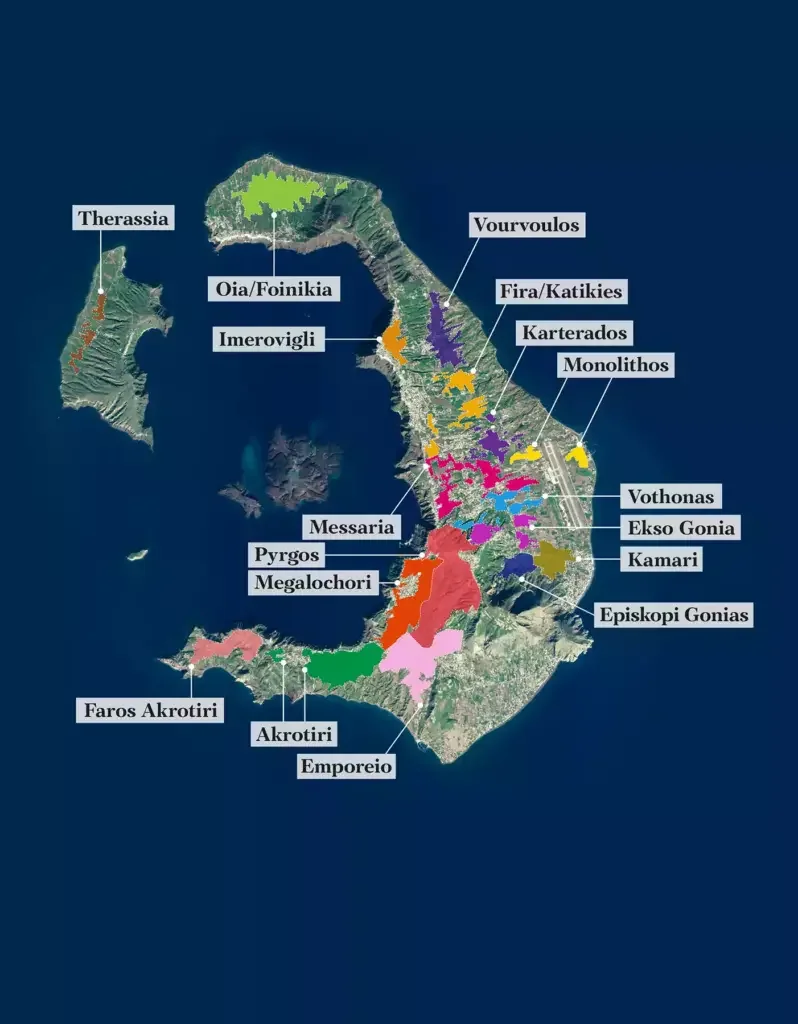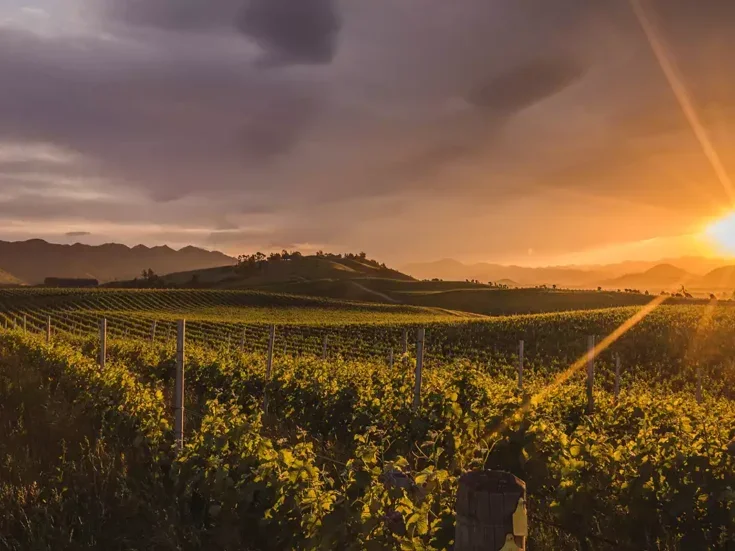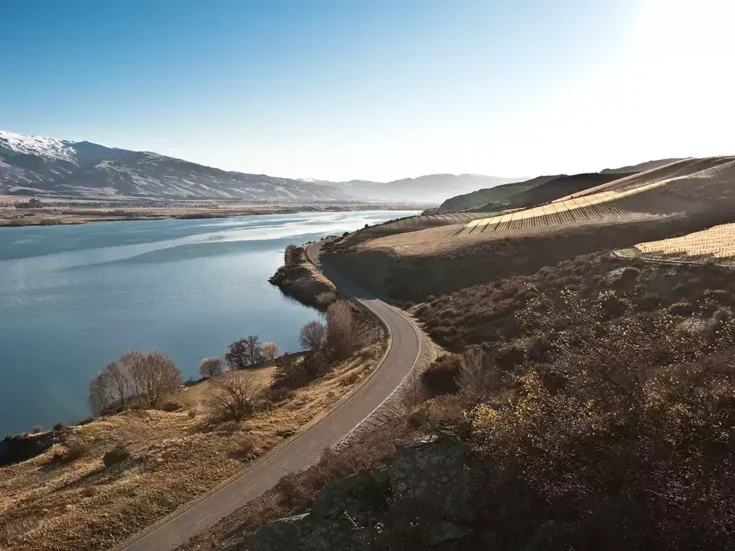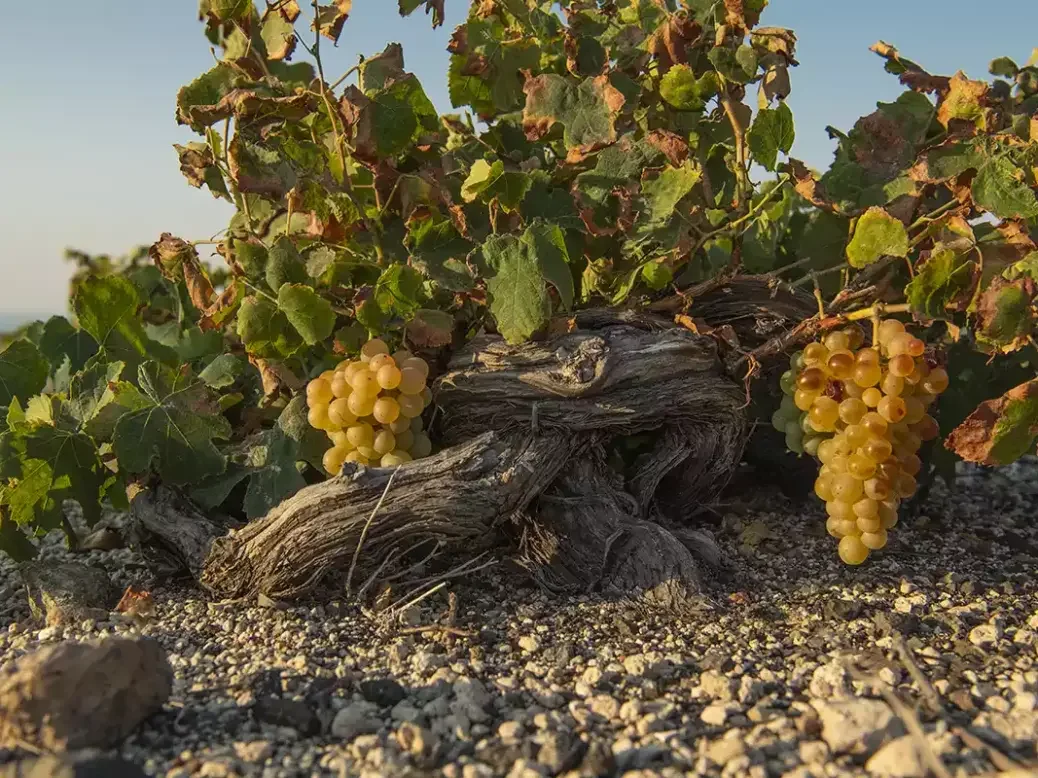
Both on and (increasingly) off its original island home of Santorini, Assyrtiko merits attention as a hardy grape variety capable of producing white wines as exciting as top Burgundy and Riesling, says Panos Kakaviatos.
A longtime family friend, chef, and wine connoisseur recently told me that “an increasing problem with Assyrtiko is that too many Greek wineries are jumping on its bandwagon.” Indeed, much has been said about this star white grape from the volcanic Cycladic Island of Santorini. In his excellent book, The Wines of Santorini, Yiannis Karakasis MW observes that Assyrtiko is the flagship for all Greek wine and that it has “found itself in top restaurants worldwide” due to its “magnificent combination of ripeness and razor-sharp acidity.”
The grape variety certainly transformed Santorini—long known for summer sunsets overlooking the caldera, the dramatic cauldron-like volcanic depression—into a wine mecca. During my first visit in 1987, few people thought about wine. Today, more than 20 wineries dot the island. Shuttle boats advertise wine tours, and wine professionals visit the island to grasp how volcanic soils influence Assyrtiko and how microclimates bring out various expressions of that ripeness and acidity. Having enjoyed much success on Santorini, Assyrtiko spread to other parts of Greece—and it has been planted more recently in California and Australia. Karakasis suggests that Assyrtiko is becoming to Greece what Riesling is to Germany. And as with Riesling, some Assyrtiko is better than others.
In visiting Assyrtiko vineyards on and off Santorini these past five years, and having organized tastings for wine pros and consumers in France, Germany, and the United States, I am confident that top Assyrtiko stands toe to toe with established world-class dry white wines. But beware the name: Just because it says Assyrtiko, it doesn’t mean you have a great white. At its best, Assyrtiko is comparable to fine dry Alsace or German Riesling and top Chardonnay, especially as expressed in Chablis. Many thanks to Yiannis Karakasis MW, Stela Kasiola, Konstantinos Lazarakis MW, Nico Manessis, Ted Lelekas, Stavroula Liapi, and many others for having helped me reach a better understanding of Assyrtiko—and Greek wines in general.
Proof in glass
In a recent single-blind tasting with wine professionals in Frankfurt (we knew the wines included Riesling, Chablis, and Santorini Assyrtiko, but not the order served), a €70 bottle of Dr Bürklin-Wolf Langenmorgen Grand Cru Riesling 2018 was rated lower by German judges than a Domaine Sigalas Santorini Assyrtiko 2009, which most tasters confused for the Daniel-Etienne Defaix Chablis Premier Cru Côte de Lechet 2008. Frankfurt-based premium wine sales manager Christine Scharrer was convinced that it was the Chablis. Barbara Fienhold of German culinary magazine Biss praised the impressive complexity and freshness of the Sigalas.
In Strasbourg, France, sommeliers came away equally impressed with Assyrtiko: “This resembles Grand Cru Chablis,” remarked Stéphan Maure of the wine bar Ill Vino, after tasting the Gaia Thalassitis Assyrtiko 2017 as “quite bone-dry with admirably reined-in mid-palate creaminess and a finish marked by wet stone.”
A big hit was the limited-edition “7” series of wines made from single vineyards named after seven Santorini villages, crafted by legendary island winemaker Paris Sigalas of the eponymous winery. “Such pristine expression of fruit and salinity evoke fine Burgundy,” remarked wine buyer Paulo Puel, after tasting the seven terroir-specific wines. The Akrotiri Village 2016 vintage, clocking in at 13% ABV and about 7.4g/l of acidity, was brisk yet also smooth and contoured on the palate, very saline, with wet stone, leading to a fresh and lifting finish. At the same time, the Imerovigli Village of the same vintage clocked in at 14.7% ABV and nearly 7g/l of acidity. The wine displayed a richer profile, with quince jelly and cooked pear. Several wine bars in Strasbourg now have Assyrtiko on their lists.
Terroir and aging potential
A November 2019 visit to Santorini as part of a WSET course led by Konstantinos Lazarakis MW proved to me how well Assyrtiko can age. A 2003 vintage of the Sigalas flagship Santorini Assyrtiko (crafted from vines in all seven village sites) when tasted 16 years later proved remarkably fresh, with 13.5% ABV. One may think that the topography on an island of around 28 sq miles (72 sq km) is similar, with maritime humidity and mists contributing to an annual rainfall of less than 14 inches (350mm). But different latitudes, altitudes, and microclimates yield different styles. Paris Sigalas speaks fluent French and admires Burgundy. He was the first on the island to experiment with single-vineyard wines, and since 2015 he has been crafting his “7” series bottlings along with an especially successful Kavalieros Assyrtiko, made from more than 60-year-old vines from a single vineyard of the Imerovigli village.
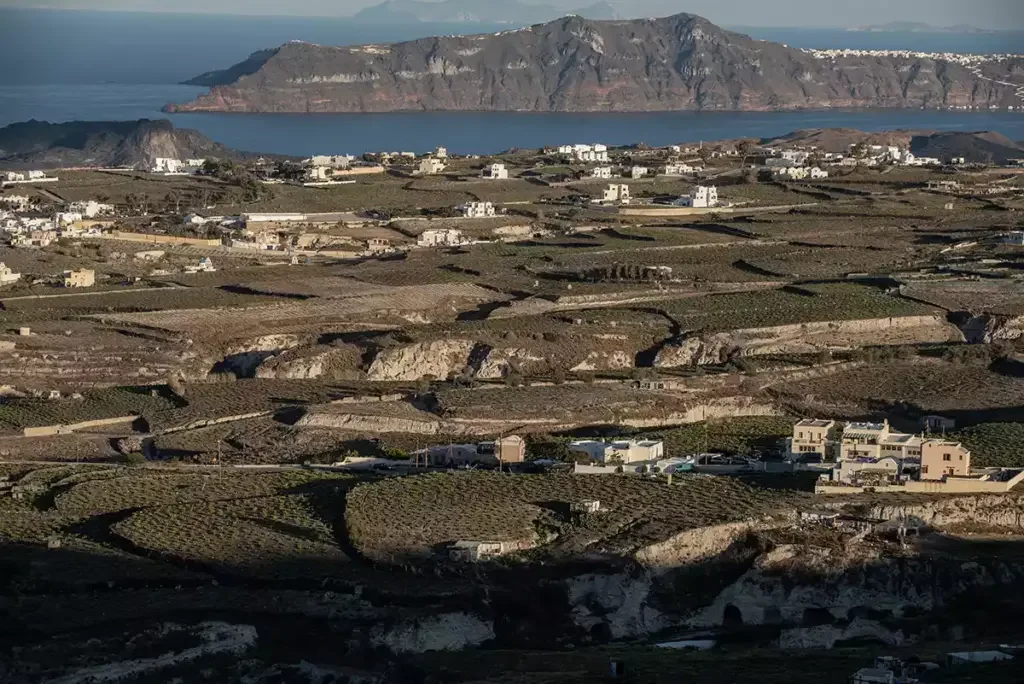
Pricing concerns
Island sources have explained that Santorini grape growers are sometimes tempted to sell vineyards for hotel development to reply to never-ending tourism thirst. In 2019, the Greek City Times dubbed Santorini the country’s most Instagrammable spot, with more than 5.2 million posts bearing the hashtag #Santorini. That has not changed since Covid. Supply and demand play a role as more island wineries require more grapes from growers. As a result, grape prices have skyrocketed over the past ten years—from €0.85 per kilo in 2010, to more than €5 in 2019, Karakasis stresses in his book. Since 2019, prices have stabilized at between €4.50 and €5.50, he says.
Many raised concerns over how increasing prices would affect sales. Yiannis Valambous, of Vassaltis Winery on Santorini, told me a few years ago that increasing prices are a “great concern” and feared that the market might say enough is enough. About the same time, John Fitter of MacArthur Liquors in Washington, DC, remarked that if Santorini breached the $30-a-bottle barrier, “I am not sure we would still carry the wines.” These days, buyers are seeking less expensive options, but Fitter says that “customers have come to admire certain premium brands at higher prices.” He sells the Vassaltis Assyrtiko Santorini 2021 for $49.99 and Santorini’s Estate Argyros Assyrtiko 2021 for $36.99, for example. For some brands, like the $50 Estate Argyros Cuvée Monsignori, “I can never keep it in stock; it is that popular,” Fitter told me this year.
In more recent years, many blends with Assyrtiko under the protected geographical indication (PGI) of the Cyclades moniker sell for less, but readers should note that these wines lack the depth and length of top Santorini wines with the protected designation of origin (PDO). It is important to note the appellation for quality.
Winemaking talent
And the winemakers. Take Matthew Argyros of Estate Argyros; these wines, Yiannis Karakasis MW says, “belong in the Champions League of Santorini producers.” Built nearly ten years ago, the winery is modern and spacious, well equipped to vinify harvests from some 130ha (320 acres) of vines, a significant proportion of which belong to the winery—a key advantage. Most Santorini estates rely heavily on growers, so Argyros enjoys more direct control—from picking, to winemaking. The flagship unoaked Argyros Assyrtiko, made from 80- to 100-year-old vines, is one of my favorites, but for a bit more money, the Cuvée Monsignori, made from 200-year-old vines, is superlative. Just after writing this article, I found a deal at $42 a bottle in the United States for the 2019 vintage—it was utterly delicious with Maryland crab cakes.
Argyros more recently launched one of the youngest wineries on the island, Volcanic Slopes Vineyards. Rather than looking for an expression of specific island vineyards, he seeks to convey “the ultimate expression” of Santorini via old-vine concentration, with the aptly named Santorini Pure wine, crafted from two parcels of vines more than 200 years in age, located in Pyrgos and Megalochori vineyards. When I opened a bottle of the 2017 vintage over dinner at Château Gazin in Pomerol last year, the Bordeaux winemakers were impressed with its “Burgundian quality.” Old vines lend concentration and character. The wine is fermented in concrete tanks, where it matures for 14 months, with lees stirred for added depth. After resting in bottle for a year in the cellar, it is released.
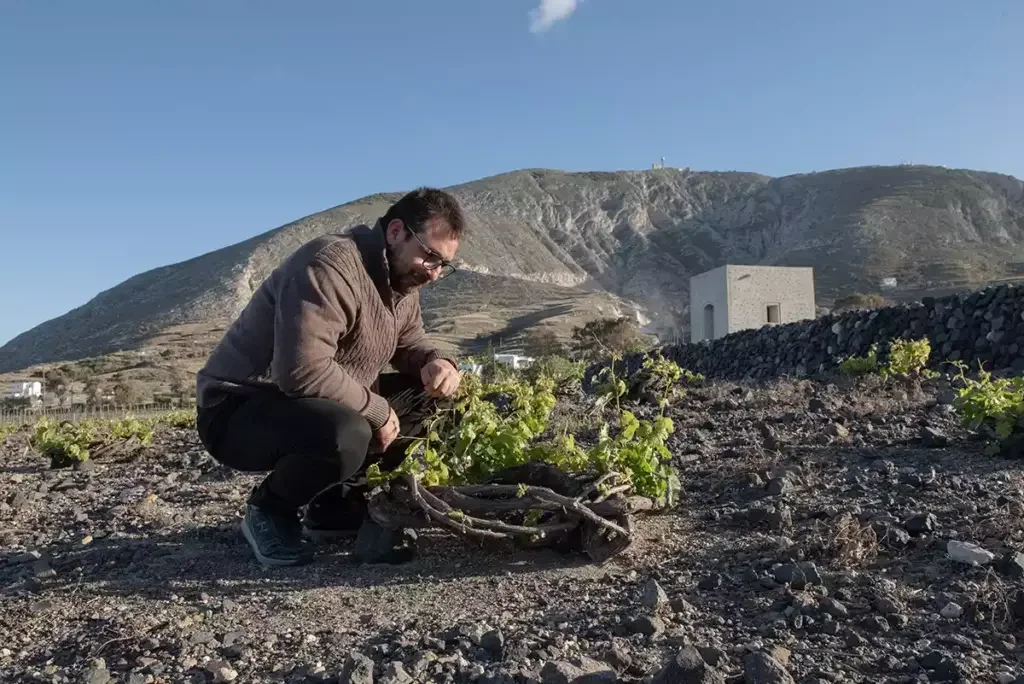
Visiting Santorini means visiting wine estates. Along with those already mentioned in this text or in tasting notes, any visit should include Gaia Estate, located close to the airport and just off the beach. I admire the charisma, passion, and talent of founder Yiannis Paraskevopoulos, who also makes excellent red wines on the Greek mainland, in Nemea. In addition to pioneering wild fermentation on the island, Paraskevopoulos experiments with aging bottles under the sea. He got the idea from a friend who suggested doing so after having read about 19th-century Champagne retrieved from a wreck off the Finnish coast in 2010 (see WFW 57, pp.78–81). The 2015 vintage, the Gaia Thalassitis Submerged, which had aged 66ft (20m) deep in the Mediterranean for four years, had remarkable freshness and density when I tried it at the winery in 2019.
Two other estates not too miss include Hatzidakis, established as one of the very best on Santorini by the much-missed Haridimos Hatzidakis. I have visited on two occasions and note that quality is being maintained by his eldest daughter and talented personnel. The wines convey an especially opulent style of dry Assyrtiko and are celebrated by consumers and critics alike. Artemis Karamolegos, the third-largest Santorini winery, traces its roots back to 1952. After tasting in the lovely courtyard, enjoy lunch or dinner at the Aroma Avlis Food & Wine restaurant just next door. Artemis Karamolegos wines regularly win prizes at international and domestic competitions. Meanwhile, the tireless Paris Sigalas last year opened a new winery named Oeno P, located in front of the sea, near the Kolumbo volcano in Baxedes-Oia. He produces only up to 20,000 bottles per year, with grapes sourced from selected vineyards, from which the wines are aged in separate amphorae.
Blending success
That Assyrtiko exudes precision and freshness can make it seem more cerebral in appeal, requiring a year or two to express itself properly. It is neither overly “fruity” nor comparable to, say, oaky Chardonnay or the easygoing Greek white Malagousia. Assyrtiko made without oak seems purer to me, though fine wines can be aged with up to 30 percent new oak. For that reason, given its acidity and precision, Assyrtiko can excel in (quality) blends.
Joining Bordeaux château owners for a rooftop dinner at the Athens Electra Palace Hotel overlooking the Acropolis in the summer of 2021, I was asked to pick Greek wines for the meal. Lilian Barton-Sartorius of châteaux Langoa and Léoville Barton, Ines de Bailliencourt of Château Gazin, and Marie-Hélène Lévêque of Château Chantegrive admired a white wine so much that they snapped photos of the bottle: The Ovilos from Ktima Biblia Chora—a winery located not on Santorini but in northwestern Greece, about a one-hour drive east of Thessalonika—blends Assyrtiko and Semillon. Vines on Mount Pangaion, where the significant diurnal temperature difference allows for excellent ripeness and cool freshness, make this blend an award-winning wine (named Best Dry White Wine in Europe by the Mundus Vini international wine competition in Neustadt, Germany) and about as crowd-pleasing as a dry white can get. Ovilos exudes the crisp freshness from Assyrtiko and juicy fleshiness from Semillon, enhanced by well-integrated oak. Effusive praise from Marie-Hélène Lévêque—who makes white Graves—was noteworthy, because the wine is modeled after classic Bordeaux blends, but with Assyrtiko rather than Sauvignon Blanc. The wine costs under $45 a bottle retail and is worth every cent.
Whose Assyrtiko?
Indeed, one should not limit Assyrtiko to Santorini. One of the best I know comes from nearby Tinos, the famously windy Cyclades island. Located 1,475ft (460m) above sea level, the T-Oinos winery has thrust the island into the modern wine-producing era. When I visited, I was struck by the vineyard’s barren moonscape; poor soil forces roots to dig past surface sand into granite bedrock. Workers wear sweaters in August. Founded by Greek businessman Alexandros Avatangelos and Gérard Margeon, executive head sommelier for Alain Ducasse restaurants, the winery’s French connection has been accentuated since 2016, when Bordeaux-based consultant Stéphane Derenoncourt joined to oversee viticulture and winemaking. The superlative flagship Clos Stegasta Asyrtiko (with one “s” on the label) retails for about $90 a bottle in the US.
For excellent price/quality ratios, try cool-climate Assyrtiko from the Greek mainland. It is said that mainland Assyrtiko is neither as chiseled nor as precise as those from Santorini, but savvy consumers can uncork fine Assyrtiko from top mainland producers, experts like Dmitri Walters MW say. Indeed, cool climates combined with poor, stony soils can yield high acidity, too. I took part in a blind tasting at Bordeaux’s International Wine Challenge from 2019, when the Plano Assyrtiko 2017 of the estate Wine Art in the northeastern region of Drama won top honors for its cool and fresh, citrus-driven expression. The harvest comes from an elevated single vineyard of rocky soil in Kali Vrisi on the eastern slopes of Mount Menoikio. Fermentation in stainless-steel tanks with lees stirring lends volume and complexity. For about $25 a bottle, you get terroir-driven Assyrtiko—from beyond Santorini.
A co-op worth its island salt
Back on Santorini, one sign of an excellent wine-producing region is its cooperative. As in Chablis, Santorini has a superlative cooperative in Santo Wines, which represents island grape growers, counting 1,200 members. Its breathtaking vistas and excellent wines at friendly prices combine to make for memorable summer experiences, as well as savvy wine purchases. Countless weddings are held year-round at the cliffside winery overlooking the caldera.
Its principal Santorini Assyrtiko, appreciated by the Strasbourg sommeliers for its salty freshness, has deservedly earned plaudits from international tastings—from a silver medal at the Mundus Vini Summer Tasting last year, to bronze at the Decanter World Wine Awards in 2019. Most important, the price: For less than $23, this is a great way to first encounter Santorini Assyrtiko.
Be sure to try the cooperative’s sparkling wine, one of my favorites from Santorini. Santo Wines was the first to craft widely distributed traditional-method Assyrtiko sparkling wine from Santorini, and it rivals excellent Alsace crémant. Early-harvested grapes from Pyrgos vineyards are cooled to 41°F (5°C), then pressed with the juice left to settle. Primary fermentation yields base wine with a neutral flavor character, high acidity, and a moderate alcohol. I was impressed by the quality of base wines from several vats with winemaker Nikos Varvarigos recently. After being stabilized and filtered, the liqueur de tirage encourages secondary fermentation. Left over a period of at least 20 months on the lees in bottle, the wine shows smooth texture with a fine bead, leading to a vivacious finish marked by wet-stone-like freshness. While contemplating the views, enjoy it with island appetizers available at the cooperative, such as the famous fava dip, made from yellow split peas.
Before buying any Assyrtiko, talk to your merchant about producers and appellations. Assyrtiko quality is such that $50 a bottle should not be considered expensive. Indeed, in her eye-opening article in the Financial Times last year—“Once tasted, the wine grape Assyrtiko is never forgotten”—Jancis Robinson MW was struck by how it was “next to impossible” to pick between fine Riesling and top Assyrtiko in a blind tasting.
Some facts about Santorini Assyrtiko
In 1971, Santorini received the recognition of the protected designation of origin (PDO) for white wines mainly made with Assyrtiko. Santorini is immune to phylloxera because the parasite cannot survive in the volcanic soil, so many vine roots found on the island are centuries old. Indigenous to Santorini, Assyrtiko has since spread to the rest of Greece—from other Aegean islands to Macedonia, central Greece, and the Peloponnese. Assyrtiko beyond Santorini maintains a crisp wet-stone-like minerality, but more often a higher level of primary fruit aromas and slightly less dense structure. The precision and laser focus of Santorini Assyrtiko is influenced by the potassium-poor volcanic soil, which contributes to lofty levels of total acidity, and very low pH levels—sometimes as low as 2.7. Very food-friendly, the high acidity works well with cheese, grilled fish, shellfish, seafood, and poultry. Most Assyrtiko wines, whether barrel-aged or matured in stainless steel or concrete, can age for at least five years, often developing aromas and flavors of ripe fruit, acacia, and intense wet stone marked by sea salt. Although not addressed in this article, sweet Assyrtiko wines called Vinsanto are crafted in a passito style from grapes dried in the sun after harvest.
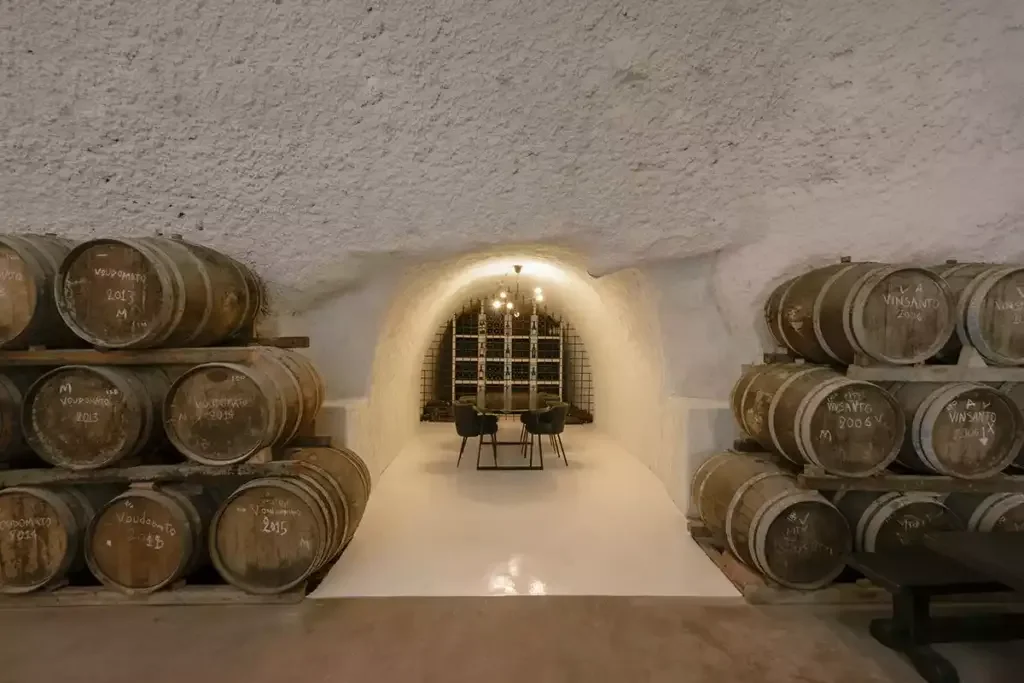
ASSYRTIKO HIGHLIGHTS
Alpha Estate Assyrtiko Ecosystem Aghia Kiriaki 2020
Lemon zest, yellow kiwi, and Indian tonic reveal mouthwatering acidity. Grapes picked from this superbly run estate in northwestern Greece come from a cool single vineyard at high altitude. Lees stirring lends richness, while the persistent finish remains fresh and crisp. Unoaked, the wine clocks in at just over 13% ABV. Try with smoked salmon or stuffed vegetables. About €25 retail. 91
Estate Argyros Cuvée Monsignori 2017
Enjoyed at the winery just after release and then last summer at a friend’s home, this ranks as one of the best Assyrtiko I know. The balance of 14.15% ABV with an astonishingly low pH of 2.87—almost 7.5g of tartaric acid per liter—takes one’s breath away. Vivacious lime and wet-stone aspects on the full-bodied palate reflect the concentration from 200-year-old vines. Such freshness, dry extract, and a long finish make for 10+ years of further aging. Fermented in stainless-steel vats at low temperatures to preserve freshness, this is aged some 11 months in stainless steel before bottling, with moderate lees stirring for added opulence. Retails for €50. 96
Gaia Wild Ferment 2017
Made from 80-year-old vines, about half the wine was aged in stainless steel, the other half in French, American, and acacia barrels. The oak is well integrated, lending an almost Meursault aspect to the wine, which nonetheless remains crisp, exuding the wet-stone saltiness typical of Assyrtiko. Try with shrimp saganaki. 13.5% ABV. About €35 retail. 93
Gavalas Santorini 2021
When I told friends about the 14.5% ABV, some thought it too high, but numbers matter less than balance. Rather full-bodied yet taut, with vivacity and youthful brightness. As Jancis Robinson MW noted last year in the Financial Times, “Assyrtiko is extremely good at hanging on to its high acidity, even in high-alcohol wines.” The low pH of 3.14 (and 6.25g per liter of tartaric acid) lends vivacity. The wine’s salinity, ripe pear, and apricot make it ideal for shrimp and seared-scallop pasta. Iconic blue bottle. About €28 retail. 92
Hatzidakis Assyrtiko de Mylos Vieilles Vignes 2011
Amber color. Aromas of sweet herb, dried almond, incense, toffee, and Riesling-like gunflint (bordering on kerosene). A wine of impressive body. Assessed blind in Frankfurt, this was a high-scoring wine, with some calling it “sensational.” The 15% ABV was balanced by soaring acidity and wonderful freshness on the long finish. Sold out. 95
Ktima Pavlidi Emphasis Assyrtiko 2021
Floral, lemon zest, and wet stone lead to refreshing acidity with a chalky palate texture. Worthy of the silver medal at the Mundus Vini summer tastings last year. With night harvesting, maximum freshness is assured from this celebrated estate in the northwestern Drama region of Greece. For the price, this is an excellent choice to pair with grilled fish, taramosalata, or cheeses. A steal at €15 retail. 90
Sigalas Kavalieros 2016
From vines nearly 70 years old, in the single vineyard of Kavalieros located around Imerovigli village, this wine shows superior breed and refinement to the “regular” Sigalas Assyrtiko. Both have aged well, but the Kavalieros shows superior depth and length. Having spent 18 months on its lees in stainless-steel tanks, this wine is now on a plateau, and there is no rush to drink up. 14.5% ABV. Retails for about €45, if you can find it. More recent vintages are easier to find. 95
Sigalas Santorini 2016
This was the primary Assyrtiko of Paris Sigalas, when he still owned the eponymous winery. Acacia, white-flower, and white-peach notes. The youthful light straw color reflects a fresh palate marked by wet stone and gunflint, reminiscent of Riesling but with a softer palate resembling cool-climate Pinot Blanc. Tasting it blind with friends earlier this year, the consensus was that it was Chablis from a warmer vintage. The finish is refreshing Indian tonic. Not a hint of oxidation. 14% ABV. Retails for about €35. 92
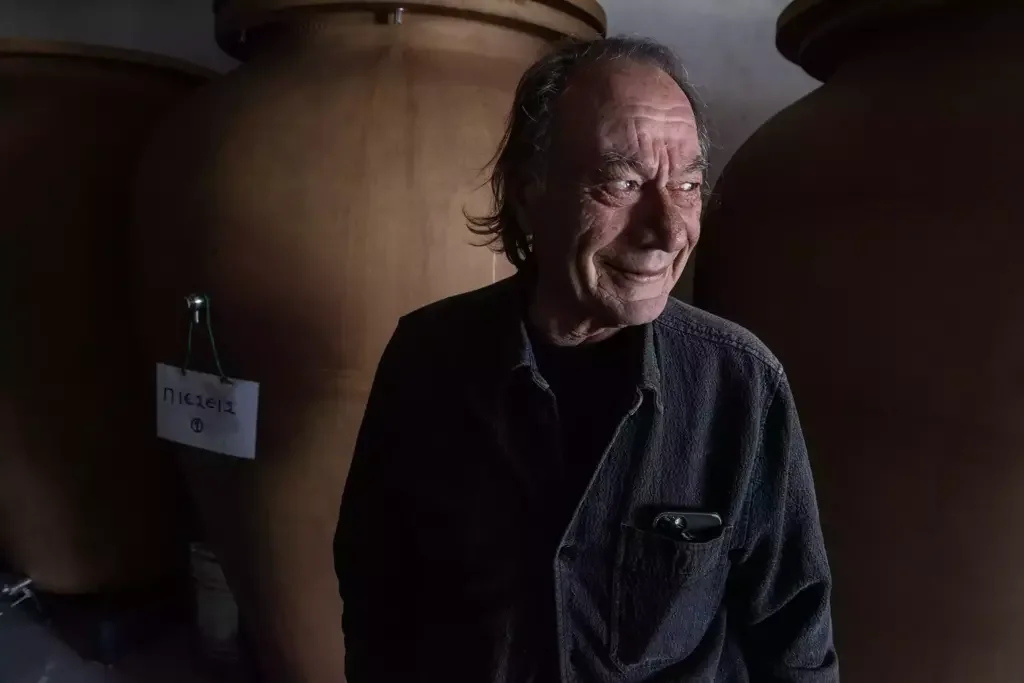
T-Oinos Clos Stegasta Assyrtiko 2018
With nuanced expressions of white flower, Key lime pie, and iodine freshness, the palate is sumptuous and crisp. The wine’s bright expression is somehow conveyed in a very deep, full-bodied palate (14% ABV), curiously reminding me of what one sometimes says for Cabernet Sauvignon-driven Bordeaux reds: the iron fist in the velvet glove. Ideal with fresh fish and seafood, the wine is made from vines of a 8ha (20-acre) plot of the same name, some 1,500ft (450m) high on Tinos. Aged in stainless steel for four months; only 6,000 bottles produced. Retails for about €90 (according to wine-searcher.com). 96
Vassaltis Santorini 2018
Enjoyed over dinner in Cyprus last year, this Assyrtiko from owner Yannis Valambous clocks in at 13.5% ABV, displaying intensity, complexity, and focus, with crunchy red-apple and juicy pear notes carried to a long finish of briny seafaring freshness. Retails for about €30. 92
Where to stay
For about €900 a week, Hotel Orizontes Santorini offers expansive views of the famous caldera—stretching from the Akrotiri lighthouse, to the famous (and too often overcrowded) village of Oia—which you can soak in while dipping a toe in the large outdoor pool. Within walking distance of Santo Winery, the hotel is near to excellent Pyrgos vineyards, where you can see old vines pruned into the kouloura or basket shapes so emblematic of the island. Enjoy coffee and a walk in the charming narrow streets of Pyrgos village, which boasts the island’s best preserved medieval settlement.
For a luxury stay—€800–1,000 for a two-night weekend—take advantage of gorgeous boutique lodgings ensconced in natural cliffside volcanic rock at Iconic Santorini. The private rooms form an amphitheater over the half-moon-shaped bay, offering amazing caldera views from private, sun-soaked terraces with individual outdoor Jacuzzis. The Imerovigli location is ideally central for vineyard visits. An in-house chef prepares fine cuisine to go with an equally impressive wine list including selections from Estate Argyros, Hatzidakis Winery, Santorini Pure, Volcanic Slopes Vineyard, and Domaine Sigalas, among others. The freshly made (and daily changing) breakfast, spa, and wellness choices, and individualized white-glove service, explain why, in 2022, World Travel Awards ranked Iconic Santorini as Greece’s Leading Luxury Boutique Hotel. I loved it.
After taking a relaxing ferry boat from Santorini to Tinos, stay at Aeolis Tinos Suites. At 1,250ft (380m) above sea level, here you can enjoy a perfect unobstructed view of other Cycladic islands with a rejuvenating North Sea breeze from the idyllic Aeolis pool. This award-winning hotel, with 45 villa-like rooms, accommodates up to 100 people, but when I stayed in September, the ratio of attentive staff to guests was two to one (only 40 residents). Built to blend into the island’s terraced hills, the hotel includes an excellent restaurant and makes for a deservedly relaxing setting after trekking the island. Peak season, the cost is about €1,800 for a week-long stay.
Where to eat
For upscale dining on Santorini, don’t miss Selene in Fira Town. I recall a splendid dinner several years ago with Santo Wines’ then marketing director Stela Kasiola and Santorini deputy mayor Markos Kafouros. The choice of 85 Santorini wines, as well as more than 200 other Greek wines, was most impressive but has improved since the arrival of Yiannis Karakasis MW as wine consultant. Since 2021, customers have been benefiting from creative tasting menus by half-Italian, half-Greek Michelin-starred chef Ettore Botrini. Friendly, professional staff welcome you to a beautiful courtyard setting.
Islanders regularly dine at To Psaraki, a fish tavern restaurant overlooking the Vlychada Marina, not only for the choice and freshness of its fish—from Mediterranean Barracuda, to red mullet—but also for excellent preparation. Starters and side dishes include local products like Santorini cherry tomato, fava beans, island capers, and white eggplant. Don’t miss the vividly flavorful homemade starter spreads, such as tzatziki and fava. Fine choice of local wines.
To Thalassaki on Tinos is one reason why Forbes and other media describe Tinos as a “hidden jewel.” Owner Aris Tatsis and chef Adonia Zarba have been running this seaside restaurant for more than 20 years, driven by a sense of freshness and precision. Take, for example, grilled calamari infused with coriander, lime, and thyme, presented with a sense of aesthetics that would make a Michelin-starred restaurant proud. A terrine of eggplant, courgette, tomato, and red pepper soaked in olive oil beckoned their fresh-baked bread. Only locally grown tomatoes were used for the salad, with high-quality salty feta to go with the fresh greens and olive oil.
Athens has countless wines bars and restaurants, but I regularly go to Blue Fish in nearby Vouliagmeni. Take a seat on the balcony abutting the sea, with its own private beach. (The nearby public beach is packed during summer months.) The wine list includes scores of fine Greek wine selections (including Assyrtiko). Superb ceviche and freshly caught tuna tartar match entry-level wines. Try the grilled sea bass, accompanied by shiitake and oyster mushrooms, or the local Greek fish called fargi, part of the red-snapper family, infused with olive oil and fresh lemon juice. The grilled octopus over braised leek and classic Santorini fava (from yellow split-peas) is among the most tender I have experienced in Greece. If you go for lunch, bring your bathing suit; then between courses, step down the short ladder to splash in the sea. Colorful side dishes of beet and carrot purées, quinoa, and potato and celery-root purées make lunch a feast for the eyes, as well as for the appetite.
What to read
Chock-full of history, winery profiles, maps, terroir analysis, details on island viticulture and winemaking, and market outlook, The Wines of Santorini by Yiannis Karakasis MW is essential reading for anyone interested in Assyrtiko.
